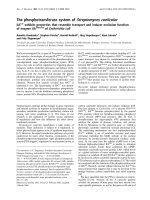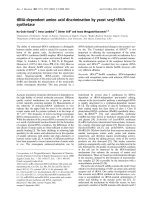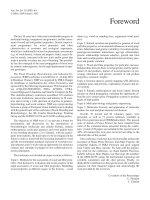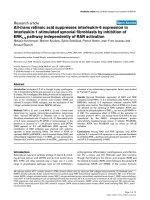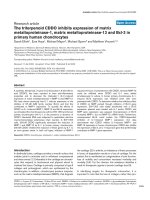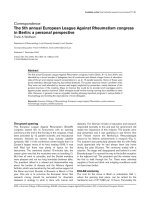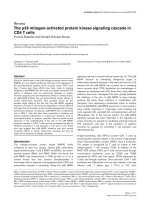Báo cáo y học: " The cationic amino acid transporter 2 is induced in inflammatory lung models and regulates lung fibrosis" pps
Bạn đang xem bản rút gọn của tài liệu. Xem và tải ngay bản đầy đủ của tài liệu tại đây (7.05 MB, 9 trang )
Niese et al. Respiratory Research 2010, 11:87
/>Open Access
RESEARCH
© 2010 Niese et al; licensee BioMed Central Ltd. This is an Open Access article distributed under the terms of the Creative Commons
Attribution License ( which permits unrestricted use, distribution, and reproduction in
any medium, provided the original work is properly cited.
Research
The cationic amino acid transporter 2 is induced in
inflammatory lung models and regulates lung
fibrosis
Kathryn A Niese
1
, Monica G Chiaramonte
2
, Lesley G Ellies
3
, Marc E Rothenberg
1,4
and Nives Zimmermann*
1,4
Abstract
Background: Arginine is an amino acid that serves as a substrate for the enzymes nitric oxide synthase (NOS) and
arginase, leading to synthesis of NO and ornithine, respectively. As such, arginine has the potential to influence diverse
fundamental processes in the lung.
Methods: We used mice deficient in cationic amino acid transporter (CAT) 2 in models of allergic airway inflammation
and pulmonary fibrosis.
Results: We report that the arginine transport protein CAT2 was over-expressed in the lung during the induction of
allergic airway inflammation. Furthermore, CAT2 mRNA was strongly induced by transgenically over-expressed IL-4,
and allergen-induced expression was dependent upon signal-transducer-and-activator-of-transcription (STAT) 6. In situ
mRNA hybridization demonstrated marked staining of CAT2, predominantly in scattered mononuclear cells. Analysis of
allergic airway inflammation and bleomycin-induced inflammation in CAT2-deficient mice revealed that while
inflammation was independent of CAT2 expression, bleomycin-induced fibrosis was dependent upon CAT2.
Mechanistic analysis revealed that arginase activity in macrophages was partly dependent on CAT2.
Conclusion: Taken together, these results identify CAT2 as a regulator of fibrotic responses in the lung.
Background
Recent studies have implicated amino acids, specifically
tryptophan and arginine, in the regulation of immunity
and tolerance. Elegant studies demonstrated an impor-
tant role for tryptophan metabolism through indoleam-
ine 2,3-dioxygenase (IDO) in inhibition of experimental
asthma [1]. However, the role of arginine transport and
metabolism remains unclear. Intracellular arginine is
metabolized by both the nitric oxide synthase (NOS) and
arginase pathways. The product of the former, NO, has
been implicated in the regulation of both inflammation
and airway tone. Similarly, products of the arginase path-
way, such as ornithine, are regulators of key processes
involved in lung inflammation, including cell hyperplasia
and collagen deposition [2,3]. Among the transport sys-
tems that mediate L-arginine uptake, cationic amino acid
transporters (CAT1, -2 or -3) are considered to be the
major arginine transporters in most cells and tissues [4].
We chose to focus on CAT2 because of its essential role
in arginine transport in immune cells, including mac-
rophages [5]. Defining the role of arginine and its trans-
port protein CAT2 has been aided by the generation of
CAT2-deficient mice [5]. While these mice are grossly
normal, their peritoneal macrophages have a 95%
decrease in L-arginine uptake and a marked impairment
in NO production [5,6]. In contrast, CAT2-deficient
fibroblasts have largely intact NO production [7]. Our
studies demonstrated that CAT2 is an essential part of
the host protective immune apparatus in the lung in that
CAT2-deficient mice displayed baseline inflammation
[8], identifying CAT2 as responsible for maintenance of
inflammatory homeostasis. A recent publication demon-
strated that CAT2-deficient mice are significantly more
susceptible to the parasite T gondii and develop enhanced
fibrosis and granuloma formation in response to S man-
soni [9]. Since arginine entry into the NOS and arginase
pathways could have multiple effects, both positive and
* Correspondence:
1
Division of Allergy and Immunology, Cincinnati Children's Hospital Medical
Center, 3333 Burnet Ave, Cincinnati, Ohio 45229, USA
Full list of author information is available at the end of the article
Niese et al. Respiratory Research 2010, 11:87
/>Page 2 of 9
negative, on lung processes during pathological condi-
tions (e.g. inflammation and fibrosis), we used CAT2-
deficient mice to test the net effect of reducing transport
of arginine in experimental asthma and experimental
lung fibrosis.
Methods
Mice
All animal studies were approved by the Cincinnati Chil-
dren's Hospital IACUC committee. Mice were bred "in
house" in specific pathogen-free conditions. CAT2-defi-
cient [5], STAT6-deficient [10] and IL-4 transgenic [11]
mice were described previously. CAT2-deficient mice
were either on the FVB/N or C57Bl/6 background. Both
strains have been backcrossed for more than 10 genera-
tions.
Induction of experimental disease models
Mice were allergen challenged as described previously
[12-14]. Briefly, mice were sensitized intraperitoneally
(i.p.) with ovalbumin (OVA, 100 μg) in alum (1 mg) and
challenged intranasally (i.n.) with 50 μg OVA or saline.
After instillation, mice were held upright until alert. Mice
were sacrificed 18-24 hours following the last challenge.
For the bleomycin model, mice were treated with a single
dose (0.03 U/mouse) of Bleomycin intratracheally (i.t.)
and sacrificed 14 days later. Bronchoalveolar lavage was
performed, and cells were counted by hemocytometer
and differentiated based on morphology following Diff-
Quick staining of cytospin preparations.
In situ hybridization of mouse lung
In situ hybridization was performed as described [13]. In
brief, murine CAT2 cDNA was subcloned from Image
Consortium clone 5344352 into pBluescript, linearized
by Hind III and Not I digestion, and anti-sense and sense
RNA probes, respectively, were generated by T3 and T7
RNA polymerase (Riboprobe Gemini Core System II
transcription kit; Promega, Madison, WI). The radiola-
beled [αS
35
-UTP] probes were hybridized and washed
under high-stringency conditions.
Northern blot analysis
RNA was extracted using the Trizol reagent as per the
manufacturer's instructions. The cDNA probe, generated
from commercially available vectors [Image Consortium
clone 5344352 in pCMV-SPORT6 obtained from Ameri-
can Tissue Culture Collection, Rockville, MD], was liber-
ated with NdeI and MluI, confirmed by sequencing,
radiolabelled with
32
P, and hybridized using standard
conditions, as described previously [13].
Measurement of collagen accumulation
Collagen accumulation was determined by measuring the
content of hydroxyproline as previously described [8].
Additionally, fibrosis was evaluated histologically. Tissues
were fixed in 10% neutral buffered formalin and paraffin
embedded. Sections were stained with Masson's
trichrome to evaluate fibrosis. Scoring (0-3) represents
evaluation of intensity and extent of fibrosis determined
by an observer blinded to treatment and genotype.
Arginase activity
Arginase activity in intact cells (peritoneal macrophages
from naïve mice) was measured using incorporation of
radioactive arginine as previously described [15]. Cells (2
× 10
5
cells/100 μl PBS and 22 mM glucose/well of 96-
well-plate) were incubated with
14
C-arginine (L-
[guanido-
14
C], NEN) for 18 hours, and
14
C-urea present
in the cell supernatant was metabolized with urease.
Released
14
CO
2
was collected and measured by scintilla-
tion counting. Arginase activity in lysed macrophages
was measured using the blood urea nitrogen reagent
(Sigma Chemical Company, St. Louis, MO) according to
established techniques [16-18].
Cytokine levels
Cytokine levels were determined by Multiplex analysis on
BALF supernatant samples. Analysis was performed by
Millipore using the mouse 32 cytokine/chemokine panel.
Statistical analysis
Values are reported as the mean ± standard deviation.
The significance of differences between groups were ana-
lyzed by ANOVA using Prism software. Pairwise compar-
isons were performed by Student's t-test. Differences are
considered significant if P < 0.05. Trichrome staining
quantification scoring was tested by Mann-Whitney U
test.
Results
CAT2 is an allergen-induced gene in experimental asthma
Using microarray analysis, we identified a set of "asthma
signature" genes that provided a valuable opportunity to
define new pathways involved in the pathogenesis of
allergic airway inflammation [13,14]. This analysis was
performed on mice with experimental asthma induced by
two distinct protocols. In one protocol, mice were sensi-
tized using OVA and the adjuvant alum and subsequently
challenged intranasally with OVA or saline as control. In
other experiments, both sensitization and challenge were
achieved with the antigen Aspergillus fumigatus intrana-
sally. We were struck by the high level of transcripts for
cationic amino acid transporter 2 (CAT2) in the asth-
matic lung compared to saline-challenged lungs. We
chose to focus on this gene since arginine transported by
CAT2 can be metabolized by the arginase and NOS path-
ways, both of which may have a profound effect on
inflammation. Interestingly, microarray analysis revealed
Niese et al. Respiratory Research 2010, 11:87
/>Page 3 of 9
very specific expression of CAT2 compared with other
CAT genes. For example, the hybridization signals for
CAT1 and CAT3 were not detectable in the saline- and
allergen-challenged lung (data not shown). We substanti-
ated these findings by Northern blot analysis. In contrast
to the saline-challenged control mice which had low lev-
els of CAT2, mice challenged with OVA or Aspergillus
had significantly increased levels of CAT2 mRNA (Figure
1A and 1B, respectively). We were next interested in test-
ing the hypothesis that overexpression of IL-4, particu-
larly in the lungs, was sufficient for induction of CAT2.
Mice that overexpress the IL-4 transgene in pulmonary
epithelium (under the control of the Clara cell 10 pro-
moter) have several features of asthma including eosino-
phil-rich inflammatory cell infiltrates, mucus production,
and changes in baseline airway tone [11]. Indeed, IL-4
lung transgenic mice had a marked increase in the level of
CAT2 (Figure 1C). IL-4 signaling often involves the tran-
scription factor STAT6. Thus, we hypothesized that aller-
gen-induced CAT2 expression may be dependent on
STAT6. Wild type and STAT6-deficient mice were chal-
lenged with OVA, and CAT2 expression was detected by
Northern blot analysis. As seen in Figure 1A, CAT2
expression was significantly decreased in STAT6-defi-
cient allergen-challenged mice, compared to wild type
allergen-challenged mice. In summary, we show that
CAT2 expression is induced by allergen in a STAT6-
dependent manner.
CAT2 in situ hybridization
To begin to address the distribution of CAT2 mRNA-pos-
itive cells in the allergic lung, we performed in situ
hybridization for CAT2 mRNA. OVA/alum sensitized
mice were challenged with intranasal OVA or saline, and
in situ hybridization was performed on lung tissue
obtained 18 hours after the second allergen or saline chal-
lenge. Anti-sense staining of OVA-challenged lungs
revealed strong CAT2 mRNA expression in individual
scattered mononuclear cells, most consistent with resi-
dent macrophages (Figure 2A-E). There was no staining
of the epithelial cell lining. Identifiable eosinophils
appeared negative. There was no signal in the smooth
muscle cells of the bronchial airways or arterioles, alveo-
lar lining cells or endothelial cells. As controls, anti-sense
and sense staining of the saline-challenged lung revealed
no detectable staining (data not shown). Additionally, no
specific staining was observed when the OVA-challenged
lungs were stained with the sense probe (Figure 2F-G).
CAT2 expression is not required for allergen-induced lung
inflammation
L-arginine transported by CAT2 can be metabolized by
the arginase and NOS pathways, both of which can have a
profound effect on inflammation. In order to test the
hypothesis that CAT2 is required for allergen-induced
inflammation, we challenged wild type and CAT2-defi-
cient mice with OVA and measured the final inflamma-
tory endpoint: cell recruitment and composition in the
bronchoalveolar lavage fluid (BALF). As seen in Figure 3,
allergen-induced inflammation was comparable in wild
type and CAT2-deficient mice. The level of systemic sen-
sitization, as measured by OVA-specific IgG1, was com-
parable between wild type and CAT2-deficient mice (n =
4 experiments, data not shown). Saline-challenged
CAT2-deficient mice had baseline inflammation (primar-
ily neutrophilia) as we have previously reported [8]. In
summary, our data demonstrate appropriate inflamma-
tory responses in the lung in response to allergic stimuli.
CAT2 expression is required for collagen deposition
following bleomycin exposure
Since CAT2 was not involved in inflammation, we
hypothesized that it would be involved in lung fibrosis.
This is based on the following: 1) CAT2 is upregulated in
bleomycin-induced pulmonary fibrosis [19] and 2) argi-
nase metabolizes arginine to ornithine, which can be fur-
ther metabolized by ornithine aminotransferase to
proline, an amino acid that is often the rate-limiting sub-
strate for collagen synthesis. In order to test this hypothe-
sis, we used a strong, well-established model of
pulmonary fibrosis and treated CAT2-deficient mice with
bleomycin i.t.: this leads to chronic inflammatory infil-
trate in the alveolar spaces, mostly composed of mac-
rophages and lymphocytes, as seen in Figure 4A. Similar
induction of inflammation is seen in CAT2-deficient
mice treated with bleomycin suggesting that CAT2 is not
Figure 1 CAT2 induction by allergen challenge. In (A), wild type
and STAT6-deficient mice were allergen challenged with OVA or saline
(Sal) and CAT2 expression was determined by Northern blot analysis. In
(B), the expression ofCAT2 following intranasal challenges with Asp or
saline is shown. In (C), CAT2 expression in wild type and IL-4 lung trans-
genic mice was determined by Northern blot hybridization. The 4.5 kb
band of CAT2 mRNA is shown. The Ethidium bromide (EtBr)-stained gel
is also shown. Each lane represents whole lung RNA from an individual
mouse.
Niese et al. Respiratory Research 2010, 11:87
/>Page 4 of 9
required for the inflammatory process, similar to what
was observed with allergen-induced lung inflammation
(Figure 3). In support of these data, multiplex analysis of
cytokines and chemokines in the BALF identified that
multiple cytokines/chemokines (including IP-10, MIG,
IL-6, LIF and G-CSF) are induced by bleomycin treat-
ment at comparable levels in wild type and CAT2-defi-
cient mice (data not shown).
In order to address the role of CAT2 in collagen deposi-
tion, we measured hydroxyproline levels in the lungs of
Figure 2 In situ hybridization. Expression of CAT2 in OVA-challenged mice was evaluated by in situ hybridization. Bright-field (A) and dark-field (B)
images from an OVA-challenged mouse are shown. Panels C-E show close-ups of individual positive cells to allow for evaluation of morphology. Panels
F and G are OVA sense control.
Niese et al. Respiratory Research 2010, 11:87
/>Page 5 of 9
bleomycin-treated mice. As seen in Figure 4B, CAT2-
deficient mice had increased baseline levels of hydroxy-
proline (P = 0.02) as we have previously reported [8].
However, while wild type mice responded to bleomycin
with increased levels of hydroxyproline, CAT2-deficient
mice were unable to further increase lung fibrosis. In
order to assess the fibrosis by an independent method, we
stained lung tissue sections by trichrome staining. As
seen in Figure 4C, both wild type and CAT2-deficient
mice had areas of fibrosis and tissue consolidation
accompanied by inflammation, which is typical of day 14
lung sections in bleomycin-induced fibrosis. When sec-
tions were scored for intensity and extent of involvement
by an observer blinded to treatment, the level of lung tis-
sue fibrosis/consolidation was significantly decreased in
CAT2-deficient mice compared with wild type mice (Fig-
ure 4D and 4E). Control mice of either genotype did not
show histological evidence of fibrosis/consolidation or
inflammation (Figure 4C, D and data not shown).
CAT2 requirement for macrophage arginase activity
CAT2 may regulate fibrotic processes via arginase activ-
ity. Indeed, arginase expression is increased in the lungs
of bleomycin-treated mice [19]. Thus, we tested the
hypothesis that CAT2 is required for arginase activity in
intact macrophages by using the whole cell arginase
activity assay [15]. Peritoneal macrophages from naïve
wild type and CAT2-deficient mice were collected, and
arginase activity was measured. There was a 52.3 ± 36.4%
(P = 0.02, n = 3 experiments performed in triplicate)
decrease in arginase activity in CAT2-deficient mice
compared to strain-matched C57BL/6 control mice. A
representative experiment is shown in Figure 5A. Similar
results were obtained with FVB/N mice (60% decrease, n
= 2 experiments performed in triplicate). Importantly,
when arginase activity was measured using the lysed-cell
method as a measure of arginase expression and activity
in cells irrespective of arginine transport into cells, there
was no difference between wild type and CAT2-deficient
macrophages (arginase activity in CAT2-deficient mac-
rophages was 93.7 ± 17.6%, P = 0.69, n = 3 experiments)
(Figure 5B). These data indicate that arginase activity is
partially dependent on arginine transport through CAT2
in peritoneal macrophages.
Discussion
Recent studies have suggested a role for arginine trans-
port and metabolism in a variety of inflammatory disor-
ders. In this report, we used CAT2-deficient mice to test
the role of arginine transport in lung inflammatory con-
ditions, including experimental asthma and bleomycin-
induced lung fibrosis. Our studies revealed several novel
findings. First, we demonstrate that CAT2 mRNA expres-
sion is induced in experimental asthma and that the main
cell type expressing it is a mononuclear cell most consis-
tent with alveolar macrophages. Second, we demonstrate
that CAT2 is required for bleomycin-induced pulmonary
fibrosis. Third, in contrast to the fibrosis data, we show
that CAT2 expression is not required for lung inflamma-
tion in either allergen-induced or bleomycin-induced
models. Finally, we show that CAT2 is partially required
for arginase activity in macrophages, which may contrib-
ute to the development of fibrosis.
Even though CAT2 is induced highly in asthma, it is not
required for experimental asthma-induced inflammation.
This observation is consistent with our recent finding
that arginase is not required for allergic airway inflamma-
tion, despite high level of induction [20]. In contrast,
CAT2 was recently shown to have an important, host-
protective role in parasitic infestation models [9], similar
to studies which demonstrated a role for arginase expres-
sion in host defense in models of parasite infestation
(including Schistosome mansoni, Heligmosomoides
polygyrus, Leishmania sp, Toxoplasma gondii and
Nipostrongylus brasiliensis) [21-26]. In summary, our
data suggest a divergent role for arginase I and CAT2 in
allergic inflammation compared to parasitic responses.
Since arginase and CAT2 are prominent products of
alternatively activated macrophages, which are induced
by IL-4 in both allergic and parasitic responses, our data
suggest that alternatively activated macrophages evolved
to combat parasitic infections and are either bystanders
in allergic inflammation or have developed other effector
molecules for allergic Th2-associated responses. In con-
Figure 3 Allergen challenge of CAT2-deficient mice. Wild type and
CAT2-deficient mice were challenged with OVA. Infiltration of inflam-
matory cells in the bronchoalveolar lavage fluid is shown. Representa-
tive of 3 experiments with 3-4 mice/group is shown.
Niese et al. Respiratory Research 2010, 11:87
/>Page 6 of 9
Figure 4 Bleomycin treatment of CAT2-deficient mice. Wild type and CAT2-deficient mice (C57Bl/6 background) were challenged with bleomycin
(bleo) i.t. and BALF cells (A) and hydroxyproline levels (B) were measured 14 days later. Representative of 3 experiments is shown. Data are mean ±
standard deviation of 5-6 mice/group. In (C), representative photomicrographs of 3 individual mice stained with trichrome staining are shown (WT-
wild type; KO- CAT2-deficient mice). In D and E, quantification of trichrome staining in bleomycin-treated mice in a representative (D) and four indi-
vidual experiments (E) is shown (one using mice on C57Bl/6 background and 3 on FVB/N background). Lungs were scored on a scale from 0-3 for
intensity and extent of involvement. (D) P values by Kruskal-Wallis with Dunn's Multiple Comparison Test. (E) n = 4-8 mice/group (only bleomycin-
treated groups are shown) in each experiment with a total of 19 wild type and 21 CAT2-deficient mice. P values shown are by Mann-Whitney test. 2-
way ANOVA (variables: genotype and experiment) identified genotype as the statistically significant (P < 0.0001) source of variation (interaction and
experiment P = not significant).
Niese et al. Respiratory Research 2010, 11:87
/>Page 7 of 9
trast, we have previously demonstrated that CAT2 has a
suppressive role in baseline inflammation [8]. We specu-
late that resident immunosuppressive macrophages
require CAT2 for the maintenance of inflammatory
homeostasis in the lung, whereas highly activated M2
macrophages express CAT2 but do not require it for the
inflammatory process.
Similarly, the role of CAT2 in fibrosis is context-depen-
dent. Baseline fibrosis is increased in CAT2-deficient
mice as measured by the whole lung hydroxyproline assay
[8]. Interestingly, this baseline fibrosis is not evident his-
tologically by trichrome staining, especially when slides
are scored by an observer blinded to genotype and treat-
ment. We did not assess allergen-induced fibrosis
because fibrosis does not develop in the acute OVA-
induced model. However, we used a well-characterized
model of bleomycin-induced fibrosis, which has previ-
ously been shown to exhibit induced transcription of
CAT2 [19]. Interestingly, in this model fibrosis is depen-
dent on CAT2 as measured by either whole lung hydroxy-
proline measurement or blinded quantification of
trichrome staining. Since previous studies have shown
that proline synthesis (often a rate-limiting step in colla-
gen synthesis) is downstream of CAT2 and arginase, we
tested the hypothesis that CAT2 is required for arginase
activity in macrophages. We found a notable require-
ment, suggesting a possible role for arginase in the CAT2-
mediated fibrosis.
The requirement for CAT2 for arginase activity in mac-
rophages is controversial. Thompson et al. [9] demon-
strated that CAT2-deficient macrophages and fibroblasts
have increased arginase activity. However, their assay was
performed with ruptured cells and exogenously added
arginine (250 mM; Km for arginase is ~5 mM) thus cir-
cumventing the function of arginine transport into the
cell. Yeramian et al. [27] demonstrated decreased arginine
catabolism into ornithine and polyamines in CAT2-defi-
cient alternatively activated macrophages, suggesting the
requirement for CAT2 for arginase activity in intact cells.
In order to directly test the role of CAT2 in arginase
activity, we used the whole cell arginase activity assay
[15]. Importantly, as opposed to the assay used by
Thompson et al. [9] and by us in lysed macrophages (Fig-
ure 5B) that assesses the arginase activity in ruptured
cells or tissues and is thus primarily a reflection of the
amount of arginase expression, the whole cell assay
accounts for the role of trans-membrane transport for
arginase function. We used peritoneal macrophages since
we were unable to collect sufficient numbers of lung mac-
rophages for this assay. Our data demonstrate a partial
requirement for CAT2 for arginase activity in intact mac-
rophages, suggesting either an alternative transporter or
intracellular pool of arginine can contribute to arginase
activity. This is in contrast to NOS activity, which
depends on arginine transport from the extracellular
space [15,28,29].
Figure 5 Role for CAT2 in macrophage arginase activity. In A, peritoneal macrophages were isolated from CAT2-deficient (CAT2KO) and wild type
mice and arginase activity was measured by hydrolysis of extracellularly added
14
C-arginine by intact macrophages. A representative experiment (out
of 5 total; 3 with mice on C57Bl/6 and 2 on FVB/N background) is shown. Data are mean ± standard deviation of triplicate measurements. In (B), mac-
rophages from wild type and CAT2-deficient mice had arginase activity measured following cell lysis by detergent.
Niese et al. Respiratory Research 2010, 11:87
/>Page 8 of 9
Conclusions
In summary, we have described a pathway (involving
CAT2 and arginine homeostasis) not previously exam-
ined in the context of lung inflammation and fibrosis. We
find that while CAT2 is highly upregulated in experimen-
tal asthma, it does not have a role in allergic airway
inflammation. Rather, CAT2 is critically important for
interstitial lung fibrosis.
Abbreviations
BALF: bronchoalveolar lavage fluid; CAT: cationic amino acid transporter; NOS:
nitric oxide synthase; OVA: ovalbumin; STAT6: signal-transducer-and-activator-
of-transcription 6
Competing interests
The authors declare that they have no competing interests.
Authors' contributions
KAN, MGC and NZ performed the research; LGE provided critical reagents
(CAT2-deficient mice); MER participated in the conception and design of the
study and helped revise the manuscript; LGE and MGC helped revise the man-
uscript; NZ participated in the conception, design and coordination of the
study, analyzed the data and drafted the manuscript. All authors read and
approved the final manuscript.
Acknowledgements
The authors wish to thank Laura Koch, Amy Hajek and Erin Zoller for technical
assistance; Dr Keith Stringer for assistance with in situ hybridization; Drs. Carol
MacLeod, Sidney Morris and Ariel Munitz for critical discussions, reagents and
technical advice; and Shawna Hottinger for final edits to the manuscript. This
study was funded in part by the March of Dimes grant FY06-345 (to NZ) and by
NIH R01 AI53479-01 (to MER and NZ). Neither the March of Dimes nor the NIH
participated in study design, collection, analysis or interpretation of data, writ-
ing of the manuscript or the decision to submit the manuscript. MGC is cur-
rently at Technical Resources International, Inc. in Bethesda, Maryland.
Author Details
1
Division of Allergy and Immunology, Cincinnati Children's Hospital Medical
Center, 3333 Burnet Ave, Cincinnati, Ohio 45229, USA,
2
Division of
Immunobiology, Cincinnati Children's Hospital Medical Center, 3333 Burnet
Ave, Cincinnati, Ohio 45229, USA,
3
Cancer Center and Department of
Medicine, University of California San Diego, 3855 Health Sciences Drive, La
Jolla, California 92093, USA and
4
Department of Pediatrics, University of
Cincinnati College of Medicine, 231 Albert Sabin Way, Cincinnati, Ohio 45267,
USA
References
1. Hayashi T, Beck L, Rossetto C, Gong X, Takikawa O, Takabayashi K, Broide
DH, Carson DA, Raz E: Inhibition of experimental asthma by
indoleamine 2,3-dioxygenase. J Clin Invest 2004, 114:270-279.
2. Morris SM Jr: Regulation of enzymes of the urea cycle and arginine
metabolism. Ann Rev Nutrition 2002, 22:87-105.
3. Mills CD: Macrophage arginine metabolism to ornithine/urea or nitric
oxide/citrulline: a life or death issue. Crit Rev Immunol 2001, 21:399-425.
4. MacLeod CL: Regulation of cationic amino acid transporter (CAT) gene
expression. Biochem Soc Trans 1996, 24:846-852.
5. Nicholson B, Manner CK, Kleeman J, MacLeod CL: Sustained nitric oxide
production in macrophages requires the arginine transporter CAT2. J
Biol Chem 2001, 276:15881-15885.
6. Manner CK, Nicholson B, MacLeod CL: CAT2 arginine transporter
deficiency significantly reduces iNOS-mediated NO production in
astrocytes. J Neurochem 2003, 85:476-482.
7. Nicholson B, Manner CK, MacLeod CL: Cat2 L-arginine transporter-
deficient fibroblasts can sustain nitric oxide production. Nitric Oxide
2002, 7:236-243.
8. Rothenberg ME, Doepker MP, Lewkowich IP, Chiaramonte MG, Stringer
KF, Finkelman FD, MacLeod CL, Ellies LG, Zimmermann N: Cationic amino
acid transporter 2 regulates inflammatory homeostasis in the lung.
Proc Natl Acad Sci USA 2006, 103:14895-14900.
9. Thompson RW, Pesce JT, Ramalingam T, Wilson MS, White S, Cheever AW,
Ricklefs SM, Porcella SF, Li L, Ellies LG, Wynn TA: Cationic amino acid
transporter-2 regulates immunity by modulating arginase activity.
PLoS Pathog 2008, 4:e1000023.
10. Kuperman D, Schofield B, Wills-Karp M, Grusby MJ: Signal transducer and
activator of transcription factor 6 (Stat6)-deficient mice are protected
from antigen-induced airway hyperresponsiveness and mucus
production. J Exp Med 1998, 187:939-948.
11. Rankin JA, Picarella DE, Geba GP, Temann UA, Prasad B, DiCosmo B, Tarallo
A, Stripp B, Whitsett J, Flavell RA: Phenotypic and physiologic
characterization of transgenic mice expressing interleukin 4 in the
lung: lymphocytic and eosinophilic inflammation without airway
hyperreactivity. Proc Natl Acad Sci USA 1996, 93:7821-7825.
12. Zimmermann N, Hogan SP, Mishra A, Brandt EB, Bodette TR, Pope SM,
Finkelman FD, Rothenberg ME: Murine eotaxin-2: a constitutive
eosinophil chemokine induced by allergen challenge and IL-4
overexpression. J Immunol 2000, 165:5839-5846.
13. Zimmermann N, King NE, Laporte J, Yang M, Mishra A, Pope SM, Muntel
EE, Witte DP, Pegg AA, Foster PS, et al.: Dissection of experimental
asthma with DNA microarray analysis identifies arginase in asthma
pathogenesis. J Clin Invest 2003, 111:1863-1874.
14. Zimmermann N, Mishra A, King NE, Fulkerson PC, Doepker MP, Nikolaidis
NM, Kindinger LE, Moulton EA, Aronow BJ, Rothenberg ME: Transcript
Signatures in Experimental Asthma: Identification of STAT6-Dependent
and -Independent Pathways. J Immunol 2004, 172:1815-1824.
15. Li H, Meininger CJ, Hawker JR Jr, Haynes TE, Kepka-Lenhart D, Mistry SK,
Morris SM Jr, Wu G: Regulatory role of arginase I and II in nitric oxide,
polyamine, and proline syntheses in endothelial cells. Am J Physiol
Endocrinol Metab 2001, 280:E75-82.
16. Wei LH, Jacobs AT, Morris SM Jr, Ignarro LJ: IL-4 and IL-13 upregulate
arginase I expression by cAMP and JAK/STAT6 pathways in vascular
smooth muscle cells. Am J Physiol Cell Physiol 2000, 279:C248-256.
17. Wei LH, Wu G, Morris SM Jr, Ignarro LJ: Elevated arginase I expression in
rat aortic smooth muscle cells increases cell proliferation. Proc Natl
Acad Sci USA 2001, 98:9260-9264.
18. Li H, Meininger CJ, Kelly KA, Hawker JR Jr, Morris SM Jr, Wu G: Activities of
arginase I and II are limiting for endothelial cell proliferation. Am J
Physiol Regul Integr Comp Physiol 2002, 282:R64-R69.
19. Endo M, Oyadomari S, Terasaki Y, Takeya M, Suga M, Mori M, Gotoh T:
Induction of arginase I and II in bleomycin-induced fibrosis of mouse
lung. Am J Physiol Lung Cell Mol Physiol 2003, 285:L313-321.
20. Niese KA, Collier AR, Hajek AR, Cederbaum SD, O'Brien WE, Wills-Karp M,
Rothenberg ME, Zimmermann N: Bone marrow cell derived arginase I is
the major source of allergen-induced lung arginase but is not required
for airway hyperresponsiveness, remodeling and lung inflammatory
responses in mice. BMC Immunol 2009, 10:33.
21. Anthony RM, Urban JF Jr, Alem F, Hamed HA, Rozo CT, Boucher JL, Van
Rooijen N, Gause WC: Memory T(H)2 cells induce alternatively activated
macrophages to mediate protection against nematode parasites. Nat
Med 2006, 12:955-960.
22. Iniesta V, Gomez-Nieto LC, Corraliza I: The inhibition of arginase by
N(omega)-hydroxy-l-arginine controls the growth of Leishmania inside
macrophages. J Exp Med 2001, 193:777-784.
23. Zhao A, Urban JF Jr, Anthony RM, Sun R, Stiltz J, van Rooijen N, Wynn TA,
Gause WC, Shea-Donohue T: Th2 cytokine-induced alterations in
intestinal smooth muscle function depend on alternatively activated
macrophages. Gastroenterology 2008, 135:217-225.
24. Hesse M, Modolell M, La Flamme AC, Schito M, Fuentes JM, Cheever AW,
Pearce EJ, Wynn TA: Differential regulation of nitric oxide synthase-2
and arginase-1 by type 1/type 2 cytokines in vivo: granulomatous
pathology is shaped by the pattern of L-arginine metabolism. J
Immunol 2001, 167:6533-6544.
25. Rutschman R, Lang R, Hesse M, Ihle JN, Wynn TA, Murray PJ: Cutting edge:
Stat6-dependent substrate depletion regulates nitric oxide
production. J Immunol 2001, 166:2173-2177.
26. El Kasmi KC, Qualls JE, Pesce JT, Smith AM, Thompson RW, Henao-Tamayo
M, Basaraba RJ, Konig T, Schleicher U, Koo MS, et al.: Toll-like receptor-
Received: 25 February 2010 Accepted: 24 June 2010
Published: 24 June 2010
This article is available from: 2010 Niese et al; licensee BioMed Central Ltd. This is an Open Access article distributed under the terms of the Creative Commons Attribution License ( ), which permits unrestricted use, distribution, and reproduction in any medium, provided the original work is properly cited.Respiratory Research 2010, 11:87
Niese et al. Respiratory Research 2010, 11:87
/>Page 9 of 9
induced arginase 1 in macrophages thwarts effective immunity
against intracellular pathogens. Nat Immunol 2008, 9:1399-1406.
27. Yeramian A, Martin L, Serrat N, Arpa L, Soler C, Bertran J, McLeod C, Palacin
M, Modolell M, Lloberas J, Celada A: Arginine Transport via Cationic
Amino Acid Transporter 2 Plays a Critical Regulatory Role in Classical or
Alternative Activation of Macrophages. J Immunol 2006,
176:5918-5924.
28. Lee J, Ryu H, Ferrante RJ, Morris SM Jr, Ratan RR: Translational control of
inducible nitric oxide synthase expression by arginine can explain the
arginine paradox. Proc Natl Acad Sci USA 2003, 100:4843-4848.
29. Rajapakse NW, Mattson DL: Role of L-arginine in nitric oxide production
in health and hypertension. Clin Exp Pharmacol Physiol 2009, 36:249-255.
doi: 10.1186/1465-9921-11-87
Cite this article as: Niese et al., The cationic amino acid transporter 2 is
induced in inflammatory lung models and regulates lung fibrosis Respiratory
Research 2010, 11:87
